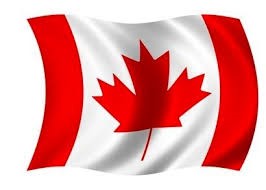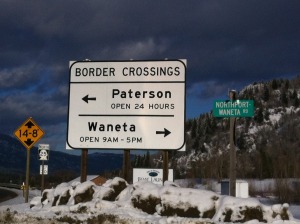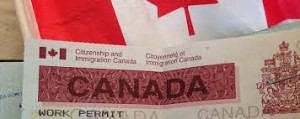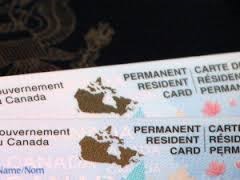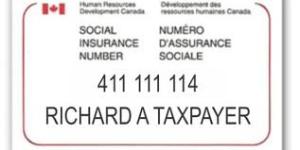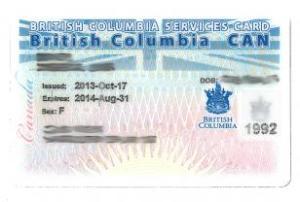Welcome to “An American in Kelowna”
“You never really know a man until you stand in his shoes and walk around in them”
― Harper Lee, To Kill a Mockingbird
Atticus Finch had his shoes. These are mine.
Where do I start?
My first 100 days in Kelowna have been like a smart kid’s report card, all A’s: acknowledgeable, adaptable, appreciative, auspicious, and a little bit angst-ridden. Oh, Canada – you had me at hello and that first time I drove up to the Paterson Border Crossing and faced off with a couple no-nonsense border agents.
The good news is that I made it across the border (on the second try, more on that later in another post) via a single entry Canada Visitor Visa.
The less-than-good news (at that time) was my Visitor Visa was only granted for 90 days (could have been six months).
The extremely better news came in late October when my Visitor Visa was renewed (after applying and sending in 100 bucks for the privilege) for ONE year. Big sigh of relief around the Jim + Elaine dinner table! One Citizenship and Immigration Canada (CIC) hurdle cleared. Time to move forward and climb new mountains.
What lies ahead? The waiting game. And lots more CIC hoops, such as:
- Qualifying for and receiving an Open Work Permit
- Gaining Permanent Resident (PR) status
- Getting a SIN – Social Insurance Number
- Becoming eligible for MSP – Medical Services Plan
What is an Open Work Permit and how do I get one?
Open Work Permits are immigration documents permitting temporary residents (that’s me, right?) to work in Canada. Unlike a standard Work Permit, an Open Work Permit is not linked to a specific employer, position, or location. As such, an Open Work Permit holder is able to assume most positions without seeking immigration approval, and may change employers without further approvals.
Who can apply for an Open Work Permit?
According to Canadaworkpermit.com, “Spouses or common-law partners of Canadians who are the subject of an approval-in-principle in an application for inland spousal sponsorship.”
Huh? I’ll need a little help understanding that sentence?!
For Canadian immigration purposes, “work” is defined as an activity for which remuneration is earned or as an activity that competes directly with activities of Canadian citizens or permanent residents in the Canadian labour market (like they told me at the border, I “cannot take work away from a Canadian”).
Normally, Work Permits will only be granted by Canadian immigration authorities if supported by a positive “Labour Market Impact Assessment” (LMIA) letter issued by Employment and Social Development Canada (ESDC), indicating that the proposed employment will not adversely affect Canadian workers.
What is Permanent Resident Status?
A Permanent Resident is someone who has been given permanent resident status by immigrating to Canada (that’s me), but is not a Canadian citizen. Permanent residents are citizens of other countries (me, again).
A person in Canada temporarily, like a student or spouse of a Canadian citizen, is NOT a permanent resident.
Once becoming a Permanent Resident, I would have the rights to:
- get most social benefits that Canadian citizens receive, including health care coverage
- live, work, or study anywhere in Canada
- apply for Canadian citizenship
- protection under Canadian law and the Canadian Charter of Rights and Freedoms
If I were to travel outside Canada, a Permanent Resident (PR) card is proof that I am a permanent resident of Canada. If I left Canada for any reason, I would need this card to re-enter the country on a commercial vehicle, like an airplane, boat, train, or bus. If my PR card expires, it does NOT mean I’ve lost Permanent Resident status.
How can I get a Social Insurance Number (SIN)?
The Social Insurance Number (SIN) is a nine-digit number that every citizen needs to work in Canada or have access to government programs and benefits. There is no fee (yeah!) to apply for it.
I would need a primary document to apply for a SIN, obtain a confirmation of my SIN, or amend my SIN record (such as a name change). A primary document is an official document that proves my identity and status in Canada. Authorities would need to see an original of my primary document.
For me, a primary document would be a Work Permit.
How and when do I become eligible for a Medical Services Plan (MSP)?
Goodbye, Obamacare. Hello, Medical Services Plan.
Elaine should be able to include me on her University of British Columbia (UBC) employee health plan once I reach eligibility status.
Under the Medicare Protection Act, enrollment with MSP is mandatory for all eligible residents of British Columbia. A resident is a person who:
- is a citizen of Canada or is lawfully admitted to Canada for permanent residence
- makes his or her home in British Columbia
- is the spouse of an eligible B.C. resident may also be deemed a resident provided that an application for Permanent Resident status has been accepted for processing by Citizenship and Immigration Canada and the application remains active
New residents in B.C. (like me) are eligible for coverage after completing a wait period that normally consists of the balance of the month of arrival, plus two months.
For example, if an eligible person arrives during the month of July (which I did), coverage is available October 1st (guess we should look into that?). A person should apply for MSP coverage immediately after arriving in B.C., rather than at the end of the wait period, to allow time for the application to be processed.
It’s mid-November. The waiting game is the big unknown.
I’m still driving with my Missouri driver’s license and Show-Me state plates on my car. For auto insurance coverage, I’m still on the same State Farm plan that I’ve had for more than 21 years. Ditto for my AAA membership.
Many things change. Others stay the same.
Anybody out there in similar shoes?
If so – send me a comment and we’ll share our hits, misses, and successes.
